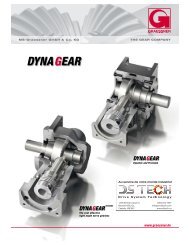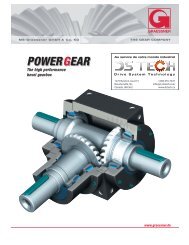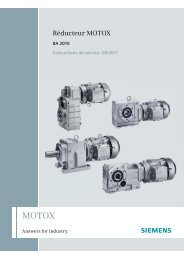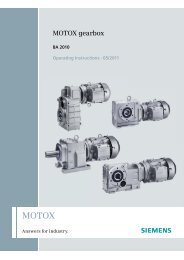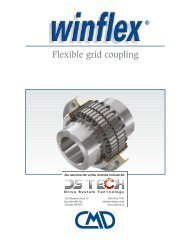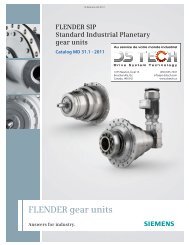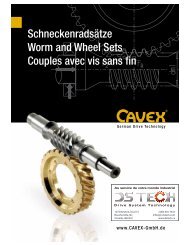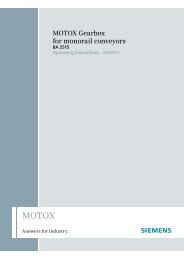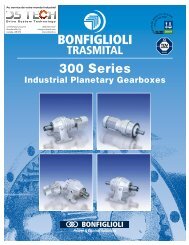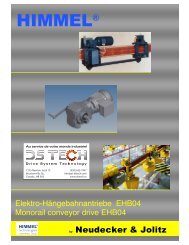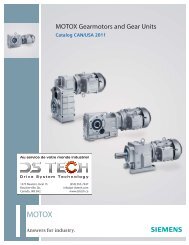FLENDER Standard Couplings - DS TECH
FLENDER Standard Couplings - DS TECH
FLENDER Standard Couplings - DS TECH
- No tags were found...
Create successful ePaper yourself
Turn your PDF publications into a flip-book with our unique Google optimized e-Paper software.
© Siemens AG 2011<br />
<strong>FLENDER</strong> <strong>Standard</strong> <strong>Couplings</strong><br />
Technical Information<br />
Corrosion protection<br />
Coupling behavior under overload conditions<br />
1275 Newton, local 15<br />
Boucherville, Qc,<br />
Canada, J4B 5H2<br />
Depending on the environmental conditions, suitable corrosion<br />
protection must be specified for the coupling. Unless otherwise<br />
specified in the order, steel and cast iron surfaces are shipped<br />
with a simple preservative.<br />
Ambient conditions<br />
Because of the environment, the coupling has to meet a large<br />
number of additional requirements. <strong>Couplings</strong> must be as suitable<br />
for use in a potentially explosive environment as for use at<br />
a high or low ambient temperature. The environment may be defined<br />
as chemically aggressive or be subject to laboratory conditions<br />
or requirements of food manufacture.<br />
ATEX and EC Machinery Directive<br />
Wherever a potentially explosive environment cannot be ruled<br />
out, the machinery used must meet special conditions in order<br />
to prevent the outbreak of fire as far as possible. Within the European<br />
Union, Directive 94/9/EC applies to these applications.<br />
This directive, also called ATEX 95, harmonizes the individual<br />
states' legal requirements for explosion prevention and clearly<br />
defines the procedure for checking and circulating machines<br />
and parts. Whether or not a machine is used in a potentially explosive<br />
environment, the manufacturer is required under EC Machinery<br />
Directive 98/37/EC to assess and as far as possible prevent<br />
hazards which may arise from his product.<br />
The operator has an obligation to ascertain whether an environment<br />
is potentially explosive. Details of this are laid down in<br />
Directive 1999/92/EC, also known as ATEX 137.<br />
The manufacturer is responsible for ensuring that the product is<br />
safe as defined in the EC Machinery Directive and conforms to<br />
Directive 94/9/EC if the EX requirement is specified by the operator.<br />
The drive train mostly comprises individual pieces of equipment<br />
which are put together to form a subassembly. If the individual<br />
pieces of equipment, such as motor, coupling, gear unit or<br />
driven machine conform to Directive 94/9/EC, the manufacturer<br />
of the overall unit can limit the risk assessment to the additional<br />
hazards which arise from the combination of different individual<br />
pieces of equipment. The hazards which can arise from the individual<br />
pieces of equipment are assessed by the relevant suppliers.<br />
The coupling series suitable for use in potentially explosive environments<br />
are marked with EX in the catalog.<br />
<strong>FLENDER</strong> couplings are to be rated as components according<br />
to the new EC Machinery Directive 2006/42/EC. Therefore,<br />
Siemens do not issue a declaration of incorporation for<br />
this products.<br />
Coupling behavior under overload where the torque is considerably<br />
above the limits of use of the coupling concerned is determined<br />
by the engineering design of the coupling series.<br />
The ZAPEX, ARPEX, N-EUPEX, RUPEX and BIPEX coupling series<br />
can withstand overloads until the breakage of metal parts.<br />
These coupling series are designated as fail-safe. Coupling<br />
types which can withstand overload, i.e. fail-safe types, are used<br />
e.g. in crane systems. In case of coupling breakage due to overloads,<br />
the splintering metall parts may cause injury to persons<br />
and property damages.<br />
The N-EUPEX <strong>DS</strong>, ELPEX-B, ELPEX-S and ELPEX coupling series<br />
throw overload. The elastomer element of these couplings is<br />
irreparably damaged without damage to metal parts when subjected<br />
to excessive overload. These coupling series are designated<br />
as non-fail-safe. The types that fail can be fitted with a failsafe<br />
device. This component enables emergency operation,<br />
even after the rubber element of the coupling has been irreparably<br />
damaged.<br />
The fluid couplings of the FLUDEX series withstand a load for a<br />
short time. Persistent overload causes the FLUDEX coupling to<br />
heat up beyond limits, causing the fuse to operate and so emptying<br />
the coupling and interrupting the torque transmission.<br />
Torsional and bending vibrations<br />
On drives which are prone to torsional and bending vibrations,<br />
measurements or calculations such as natural frequency calculations,<br />
torsional vibration simulations or bending vibration calculations<br />
are necessary.<br />
The drive train may, depending on complexity, be regarded as a<br />
two-mass vibration-generating system or N-mass vibration-generating<br />
system. The vibration-generating masses are defined by<br />
the rotating bodies and the couplings by the coupling stiffnesses<br />
and shaft stiffnesses. The effect of torsional vibration excitations<br />
on the behavior of the system is calculated.<br />
Torsional vibration excitations may occur during the starting of<br />
an asynchronous motor, during a motor short circuit or in diesel<br />
engine drives. Bending vibrations may be critical if the coupling<br />
is insufficiently balanced and/or at an operating speed close to<br />
the critical speed.<br />
The details needed for calculating torsional vibration are specified<br />
in the coupling catalog:<br />
• Dynamic torsional stiffness<br />
•Damping (specification of the damping coefficient ψ or Lehr's<br />
damping D = ψ/4π).<br />
• Mass moment of inertia of the coupling halves.<br />
2<br />
Overload conditions<br />
Overload conditions are operating conditions that go beyond the<br />
limit loads of the coupling.<br />
Overload conditions may occur under abnormal operating conditions,<br />
e.g. drive blockage, short circuit or supply deviations, as<br />
well as under normal operating conditions, e.g. during starting<br />
or breaking. Particularly in the case of high mass moments of<br />
inertia of the driven machine, torques that are a multiple of the<br />
motor starting torque may become effective during direct starting<br />
or star-delta starting.<br />
(450) 655-7447<br />
info@pt-dstech.com<br />
www.dstech.ca<br />
Overload conditions may damage not only the coupling but also<br />
the entire drive train.<br />
Overload conditions can frequently be prevent with special design<br />
measures. SIRIUS soft starters or SINAMICS frequency<br />
converters are suitable for considerably reducing starting<br />
torques of asynchronous motors. If drive blockages and overloads<br />
of the driven machine cannot be ruled out, torque limiting<br />
SECUREX couplings can prevent damage to the drive train.<br />
Siemens MD 10.1 · 2011<br />
2/5



